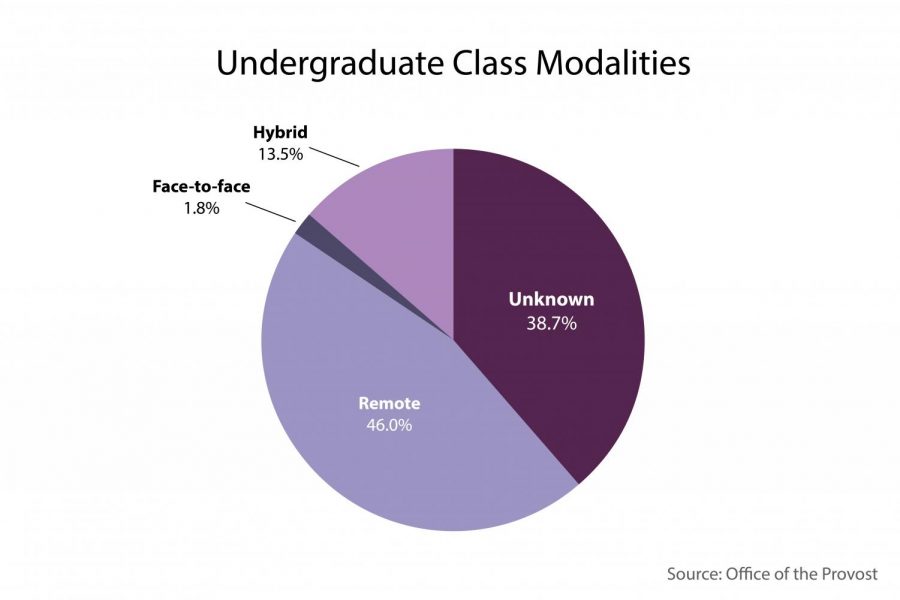Provost’s Office talks fall academic planning, course modalities in second discussion with NU community
A breakdown of the known percentages of class modality for undergraduate courses. University officials provide statistics for the first time explaining how classes will be delivered in the fall.
July 23, 2020
In the second of a series of online discussions related to Northwestern’s Phased Return to Campus plan, representatives from the Office of the Provost provided insight into planning for fall courses.
The webinar was hosted by Luke Figora, senior associate vice president and chief risk and compliance officer, and was open to the entire NU community to create a dialogue and answer questions. Jaci Casazza, associate provost for University Records and the University Registrar, kicked off the meeting and spoke about the general guidelines University officials have been following to determine academic planning across the board — from an administration level down to individual student needs.
“Most of our classes will be remote in the fall,” Casazza said. “We have very few classes in the fall that are exclusively face-to-face. They were selected to be face-to-face because the learning outcomes of the course really require it.”
University officials provide statistics for the first time breaking down how classes will be delivered in the fall. For undergraduate students, 46 percent of classes will be remote (asynchronous and synchronous), 13.5 percent will be hybrid and 1.8 percent will be face-to-face. The other 38.7 percent is unaccounted for and consists of courses whose modalities are yet to be determined.
For graduate students, the statistical breakdown provided was not consistent among individual schools. Only 1.3 percent of graduate courses will be held face-to-face. The School of Communication has the highest known percentage of in-person instruction at 5 percent.
Thirty-two percent of Medill School of Journalism, Media, Integrated Marketing Communications graduate courses will be held remotely, while 66 percent will be hybrid, a significant departure from the more generalized undergraduate statistics. At the same time, the School of Professional Studies will hold 90 percent of its courses remotely. The School of Education and Social Policy splits classes more down the middle, with 53 percent of graduate courses being held remotely and 36 percent hybrid.
“Almost all” Kellogg School of Management MBA programs will be held on a hybrid basis, according to one of the slides presented during the discussion.
“These numbers are a little lower than we expected them to be for face-to-face and hybrid,” Casazza said. “And that’s because the public health situation is changing so much. Had we done this analysis and finished our planning a month ago, the numbers might’ve been higher.”
Administrators also provided more clarity on hybrid instruction, the only of the four instruction modes NU has never implemented until now. Miriam Sherin, associate provost for undergraduate education, said one hybrid technique includes a “flipped” learning approach, which would include a mix of asynchronous content and face-to-face delivery of interactive or application activities. In a 40-person class, 10 students would learn remotely and the other 30 would be divided into groups A and B that would meet in-person at separate times to decrease classroom density.
The second hybrid approach would be a “rotation,” which includes simultaneous delivery of course content to remote and face-to-face students, Sherin said. This would still involve a group of in-person students divided into two such that they would rotate between which group learns in a classroom space each week. The third hybrid technique is a “modified rotation,” which would provide content to the group of remote students asynchronously while simultaneously engaging face-to-face students with a different activity.
“Course modalities as they are listed could change if needed,” Sherin said. “For example, some of these hybrid classes could transition to fully remote should there be a decline in the public health situation or if Northwestern receives state or local guidelines that require us to do so.”
Email: [email protected]
Twitter: @isabellesarraf
Related Stories:
— Administrators talk fall return to campus in discussion with NU community
— University provides updates on COVID-19 testing, contact tracing and safety provisions for Fall Quarter
— Registrar updates Fall Quarter scheduling timeline, modes of instruction and classroom capacities


